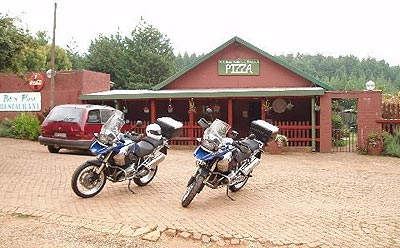| The Journal of Provincial Thought |
|
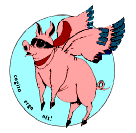 |
|||||||||||
| John Rice | ||||||||||||
| Hatari It Isn't (continued; page 2) | to page 1 | |||||||||||
| to page 3 | ||||||||||||
| ________________________________________________ | ||||||||||||
| Our next stop on the Urban Tour was the Union Building, South Africa’s seat of executive government. Absent was the D.C. style of maximum security that we encounter at the White House; we were able to park right in front of the building. (If you’ve seen the movie Invictus, we were only a few feet from the place where the Matt Damon character was dropped off by his wife when he was to make his visit to President Mandela.) | ||||||||||||
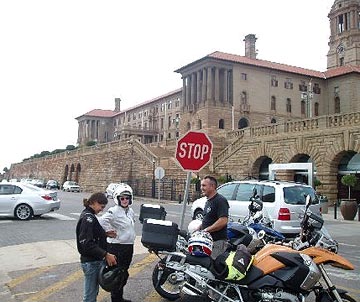 |
Tamzin, Brenda & Darryl in front of the Union Buildings. Matt Damon not visible here. | |||||||||||
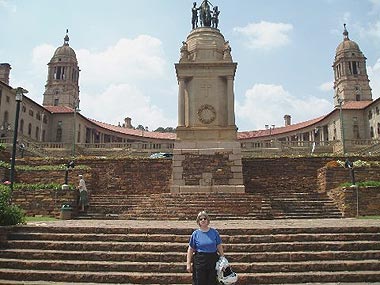 Brenda at the Union Buildings wondering why it's me and not Matt Damon taking the picture |
||||||||||||
|
The building was built with identical East and West Wings, having an amphitheater in the space between, because the Afrikaans and the British weren’t getting along so well and it was decided to give each an equivalent space from which to work out their compromises. On February 9th we got on the road at about 8:00 a.m., headed northeast toward Mpulanga. It took about 20 minutes to get out of the downtown People standing, waiting, by the side of the road. It is one of my enduring memories of our first few days' travel, and it was a continuing sight everywhere in the north we went. Small groups, usually women, standing by plastic bags containing who knows what, sometimes with large packages held casually on top of their heads. The women are often in colorful robes or shawls, with bright scarves wrapped expertly about their hair. Sometimes it is a family group, but most often women. In other areas, particularly in the morning, there are groups of men; one can assume that they are waiting for rides to work in the cities. There were buses pulled over and buses coming in both directions; but no matter how many buses we saw, there were still people standing and waiting. We often would see what looked like family groups coming through the high grass, headed toward the road. Usually a man dressed in what would be completely normal attire nearly anywhere in the States—T-shirt, jeans, ball cap—followed by a woman in long, flowing, brightly colored scarves and a robe or caftan type of garment. Following them would be two or three children, usually dressed in bright colors as well. There often were men or women pushing wheelbarrows down the side of the road to the nearby river to get water. Such contrasts in one country. Scenery that just takes your breath and leaves you without words to describe, followed soon by evidence of poverty such that we from the There was a heavy police presence on the road, with small cars identified by police markings traveling both directions, seemingly every mile or so. We were waved over for two traffic stops just to check our papers and license. One officer kept insisting he remembered me, though I find that highly unlikely, since as far as I know, I’ve never been here before. Darryl handled everything expertly and efficiently, getting us back on our way. About 10:00 we stopped for coffee at a small shopping center in what seems to be the major town in this part of the territory, Marble Hall. The shopping center is a strip design with differently colored awnings for each store, not unlike one in our country. We went to a “Wimpy” for coffee, which appeared to be a pretty standard fast-food sort of outlet like one you would find in the average American mall. Darryl paid a man sitting on the grass with a puppy, both apparently waiting for such an opportunity, to watch our bikes while we went inside. |
||||||||||||
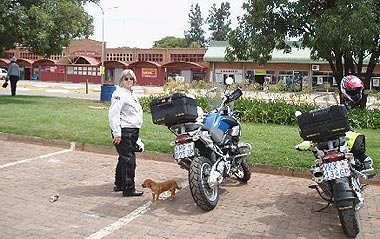 |
Brenda and newfound friend at the coffee stop | |||||||||||
|
Just outside Polokwane, Brenda saw a troop of baboons crossing the road ahead of us, but I was in the middle of making a turn and didn’t see them. Such critters were going to be a regular feature of the trip, but we always found it shocking. Deer just stare at a motorcycle...baboons look at it as if they're wondering how hard it would be to take it for a ride. We pulled in for gas at a Shell station that would not have looked out of place on any modern American interstate. A full tank of gas was 145 rand, about the equivalent of nineteen U.S. dollars. From here the mountains began in earnest, rising suddenly, impressive from the plains. Roads became one curve after another amid ever more dramatic rock formations. Everywhere one looks, the evidence of past continental collision is apparent. The rock strata are pushed up high and angular, then eroded away to patterns sculpted by eons of wind and water. In this first part of the Limpopo Province, there are scattered enormous conical hills of reddish-yellow dirt, partially worn away to reveal an interior composed of huge rounded rocks the size of SUV’s or larger, as though someone had stacked the rocks, and then coated them with dirt for protection. Or, think of a Brazil nut cluster with a light-colored chocolate coating on the outside, but the size of a five-story building....God’s own box of candy. These hills just rise at random places from flat plains between the mountains, with no apparent mechanism for their being there. I wondered if they could have been glacial moraine, considering the tumbled and smooth appearance of the rocks, but this seems unlikely. Darryl pulled over to show us By now we were far up in the mountains on roads with wide, sweeping turns and decent pavement. Darryl was setting a sporting pace, not dangerously fast but definitely not “smelling the roses” either. I've never been on an organized tour before, but I had always assumed that the pace would be slow. I was wrong, but just how wrong, I wasn't to know until the latter half of the experience. The big GS was, of course, completely in its element, carrying the two of us as if it didn’t even notice we were there. Mountain roads like this are high on the long list of the bike’s natural habitats. The scenery here seemed familiar, yet different enough that it was clear we weren’t at home anymore. There are tall trees lining the roads, like our About 1:30 in the afternoon we stopped at a restaurant on the side of the road, “The Pot & Plow.” The sign out front advertised pizza (pronounced “pit-za” here) and other meals.
Rather than your typical Domino's , however, here in the middle of the countryside in South Africa there is an Irish greeting on the door and inside, a mixture of things British, Irish, a bit of New Zealand, and African. In parts of the restaurant, we could have been on a street corner in Killarney. We ate outside at a table on the lawn, near a palm tree, which they do have in |
||||||||||||
| Back to Rice, page 1 | Return to top page 2 | |||||||||||
|
||||||||||||
| Copyright 2010- WJ Schafer & WC Smith - All Rights Reserved | ||||||||||||
